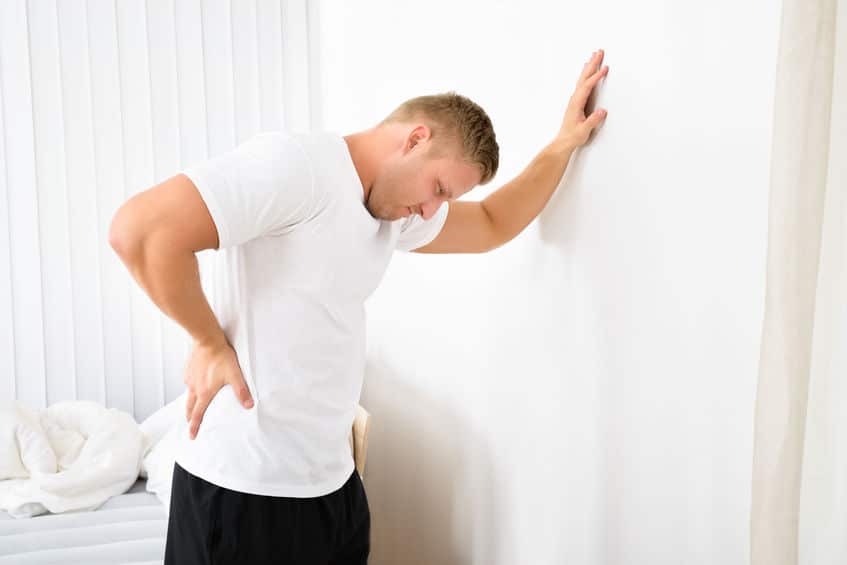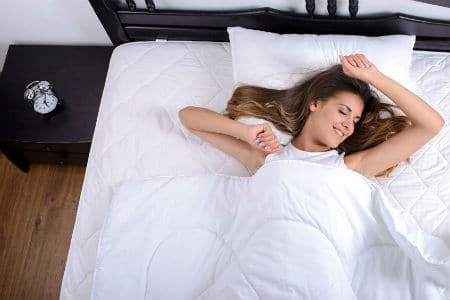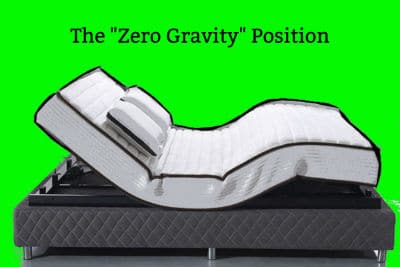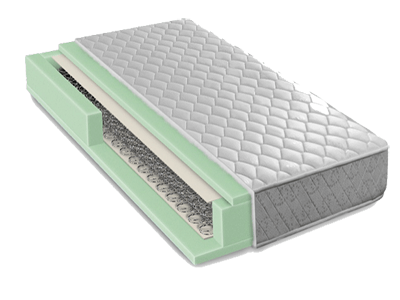What is the Best Mattress for Back Pain [2020]

Best Mattresses for Back Pain
Here's What I'll Cover in This Article:
1. The Who Health Organisation Back Pain Initiative.
2. Several high level evidence studies showing which is the best mattress for back pain.
3. Waterbeds vs a Firm Mattress – You’d Be Surprised.
4. A study showing WHY medium-firm mattresses are best for back pain.
5. Pressure relief mattresses.
6. Does Mattress Price Affect Sleep Quality?
7. Mattresses designed specifically for the individual.
8. Guiding factors for choosing a mattress.
9. NASA and The Zero G Position.
10. Can a New mattress Improve your Back Pain?
This is Crazy:
World Health Organisation on Back Pain:
The World Health Organisation is the leading body on health issues around the world and estimate the prevalence of low back pain to be around 60-70% in industrialised countries.
That’s Huge!
They consider it to be successful a major contributor to loss of work performance and quality of life to set up the World Health Organisation Low Back Pain Initiative.
To read the World Health Organisation Low Back Pain Initiative click here.
Top Study Supports the Use of Medium-Firm Mattresses.
Up until 2003 the general wisdom, including that of the majority of doctors and surgeons, was that the best mattress for back pain was a hard-trim mattress.
The problem was there was very little sound evidence to support this premise.

In 2003 Fransisco Kovacs and his team conducted a randomised, double blind, controlled trial, one of the highest levels of evidence available.
“Double Blind” means that neither the participant NOR the person conducting the study is aware of which mattress the subject was being given,
This helps to rule out any bias that may be subconsciously conveyed by the person giving the mattress to the participant.
Randomised also means that the participants are chosen at random, therefore bias is eliminated at the choosing level as well.
The Results?
In his survey of 313 patients who were suffering from lower back pain Kovacs observed that patients using a medium-firm mattress reported less pain when lying in bed and less pain on rising, than the people who were sleeping on a firm mattress.
So How Firm is Firm?
Commonly used terms such as “soft”, “medium”, “medium-firm”, and “firm” don’t mean a lot unless we have a standard to go by.
So mattress firmness is now rated on a scale developed by the European Committee for Standardisation.
The Hs scale starts at 1·0 (firmest) and stops at 10·0 (softest).
The only problem? Not all bodies worldwide adhere to this classification system.
Even Higher Levels of Evidence:

Some researchers at the Oxford University (L. Hailey N. Roberts, D. Spurden, J. Wray, A. Burls) conducted a systematic review (highest of all evidence levels whereby research is done on all the studies conducted and how rigorous they were to determine what the evidence says as a whole) of the studies conducted worldwide on how effective “orthopaedic” mattresses were in reducing low back pain.
The only reliable evidence they could find was that medium/firm mattresses had a positive effect in reducing low back pain over all other mattress types.
It Gets Better!
Another study published in the Nursing Standard 2004 tested patients with low back pain by giving some a medium firmness and others a firm firmness mattress.
They found that patients who slept on the medium firmness mattresses had significantly better outcomes than those on the firm mattresses.
They had less pain on rising and less disability using a 24 point questionaire.
This study further adds to the evidence that a firm mattress can do more damage than good to people with low back pain.
Leading Experts in The USA Agree:
Below are two quotes from the conclusions of a study in The Journal of the National Sleep Foundation, into the best mattress for back pain.
“Soft mattresses decrease excessive compressive forces on joints, especially helpful for those of us who live with arthritic conditions. On the other hand, firm mattresses help maintain appropriate sleeping posture, especially in side-lying position, as it prevents the sagging of the pelvis. However, the clinical value of such findings has not been confirmed yet.”
And this:
“Medium-firm mattresses tend to be beneficial for individuals with chronic nonspecific low back pain and were rated as more comfortable than soft bedding systems. Studies have shown that medium-firm mattresses improve sleep quality by 55% and decrease back pain by 48% in patients with chronic low back pain.” Spine-Health.com have wonderful resources to help you choose the best mattress for your low back pain.
Surely Firm is Better than a Waterbed or Foam Mattress?
The answer is no.
You would really think that a foam mattress or especially a waterbed would be worse for back pain than a firm mattress, but it seems they are better!
A study was done on patients with chronic Low Back Pain (LBP), testing a waterbed, a foam mattress and a firm mattress.
They found no significant difference between the waterbed and the foam mattress.
But the Firm mattress made low back pain significantly worse!

In fact, many of the participants of the study assigned to a hard mattress dropped out due to increased pain!
This means that it is a difficult balance to try and negotiate when finding a mattress.
Too soft and you may not get the support, too firm and you risk flaring up low back pain.
But What Makes a Medium-Firm Mattress the Best Mattress For Back Pain?
Jenny MCConnell wrote an article in The Lancet (one of the world’s leading medical journals), looking for a biological answer to WHY a medium-firm mattress helps to relieve low back pain.
She stated,
“Recent evidence has emerged suggesting that patients with chronic low-back pain lying on a conventional flat mattress have higher electromyographic activity of the erector spinae muscles and higher heart rates than controls lying on a conventional mattress.
This finding may support Kovacs and colleagues’ contention that the improvement in the symptoms of patients using a mattress of medium firmness, rather than a firm mattress, could be due to changed “muscular function and pressure distribution when lying in bed.”
G Zseto and his team published a paper in the Journal of Sleep Research which took this idea further.
They tested the muscle activity in patients with chronic low back or neck pain by replacing their usual mattress with one designed to support their backs.
They found that upper trapezius muscle and the lumbar muscle activity was significantly reduced during sleep on the specially designed mattresses.
This also correlated with a 20% reduction in the pain scores reported while using the special beds.
This gives some insight into what is actually happening to our back muscles when we sleep in a medium-firm bed, making me wonder if maybe we should all be in a medium-firm to look after our backs before they get sore.
Does Price Matter?

A study was conducted to measure the link between sleep quality, back pain, and mattress quality.
Enke, Walton and Trau equipped nine rooms in a hotel with new mattresses with 3 differing qualities and price points and compared them to the remaining 8 year old mattresses already in the hotel.
Their main conclusions:
Sleep quality was improved with a more expensive high quality mattress, for chronic sufferers of back pain and sleep problems
They also found that new mattresses produced better sleep than old mattresses.
Is Medium to Firm that Simple?
Unfortunately it is not always as simple as buying a mattress that is medium to firm.
Many people find that they sleep best on one of the newer technology memory foam mattresses, yet others find they get the best sleep on an older style inner spring mattress.
The preferred density can still vary a lot across people with low back pain.
Some find they need something really quite soft to ease their aching possibly ageing bones and joints, whereas others would almost rather sleep on a firm plank than a bed that gives and conforms to their body.
You’re never going to find one mattress that will work for everyone, and that is why there is still so much variance
Pressure Relief Mattresses
A Different Approach - testing married couples sleeping.
Another type of sleep study was conducted by Wake Forest University School of Medicine, Winston-Salem, NC 27106, USA by researchers W. Vaughn McCall a, *, Niki Boggs a, Alan Letton.
They compared a standard type of mattress with a 7-zone mattress specifically designed to relieve pressure points.
Six married couples (average age 34.8 years) were randomly assigned to sleep on a queen-size conventional mattress for 2 weeks and a specially-designed pressure-relief mattress for 2 weeks.

This is a great idea for an experiment because most tests are done on people sleeping alone, when the fact is, most of us sleep with a partner!
They measured three variables: Actigraphic (or wrist worn sleep monitoring devices); areas of high pressure, and self reported sleep quality.
Interestingly the self reported sleep and actigraphic measures showed no change.
What did improve though was the amount of pressure in high stress points like shoulders and hips.
This suggests that pressure-relief mattresses could be helpful in people with conditions such as osteoporosis-arthritis which cause pain in areas of high pressure.
Individually Designed Mattresses - are They Worthwhile?
Bert Jacobson and his team designed an experiment to determine whether a mattress designed specifically for each person can have positive effects.
They asked participants questions about pain in the back, shoulders and the quality of their sleep on their own beds, and then after spending time on a bed designed specifically for them.
They found significant reduction in pain in both the lower back and shoulders and an improvement in sleep quality on the individual specific mattress.
The mattresses in this study were all supplied by one company, Ameri-sleep.
Zero G Position - From NASA with Ahhhh.
Some people with chronic back pain may find great temporary relief from being in the “Zero G” position in their Foam mattress with adjustable bases. Like the one in the picture above.
Mattresses with the zero G position claim to hold the person in a position that puts very little stress on their body, just like you are floating in space (hence the name “Zero G”).
NASA first developed beds in the Zero Gravity position in order to simulate the effects of no gravity.
As a long time back pain sufferer I’d like to thank NASA!
I found it to be an extremely comfortable position which did seem to take all the weight off my sore back and legs.

Not a position that a side sleeper would be able to use, but I think the best use for this position is to lie in it for half an hour or more at the end of the day when you need some relief.
Read my blog on the best mattresses for side sleepers here.
Sometimes a New Mattress is All it Takes.
An interesting finding from a few of the studies was that sometimes a subject’s back pain was reduced by a new mattress, no matter what type of new mattress it was.
The recommendation is that any mattress older than 7 years should be considered near the end of its life.
Of course this does depend on the quality of the mattress in the first place and the amount of stress it is placed under, for want of a better phrase.
What Type of Mattress Should You Choose?
It’s pretty clear by now that the best mattress for back pain is a medium to Firm one.
But which type of medium/firm mattress should you choose?
Let’s have a look at the different types of mattresses available.
Materials
Materials used in the manufacture of beds has changed dramatically over the past couple of decades.
For many years it was thought that the only good mattress for sore backs is a top quality inner spring mattress.

Some of the most common materials used in mattresses today are:
- Inner Spring – several types including Bonnell, Offset, Continuous, and Marshall.
- Foam – the range of foams available is huge including latex, memory and high density.
- Combination of spring and foam.
- Water beds
- Cotton
- Horse hair.

Coils - 3 Main Types
Continuous Coils:
Continuous Coils are formed from a single piece of wire and acting with a hinging effect;
"Mira-coil" is Leggett & Platt's brand name for their continuous coils:
They are an innerspring configuration in which the rows of coils are formed from a single piece of wire.
This produces a hinging effect similar to that of offset coils.

Bonnell Coils:
These were the first version of an inner spring coil in cushions or mattresses.
Many mid-priced mattresses still contain these coils.
The coils are laced together with cross wire helixes.
Offset coils:
These coils are similar to the Bonnell coils but segments of the top and bottom of the coils are flattened, these flattened portions are then hinged together with helical wires.
This hinging is designed to conform to the body shape.
Foam Mattresses:
Most mattress companies producing foam mattresses now use differing versions of Memory Foam.
Originally named Temper Foam, memory foam was developed under a NASA contract in the 1970s that set out to improve seat cushioning and crash protection for airline pilots and passengers.
Memory foam has widespread commercial applications, in addition to the popular mattresses and pillows, and increasingly in shoes. (https://www.nasa.gov/offices/ipp/home/myth_foam.html)
Advantage of Memory Foam:
The great advantage of memory foam is that it will quickly adopt your body shape and return to its normal shape once you get up.
Another advantage is that you are not interrupted by movements of your bed partner during the night.
This allows better quality, uninterrupted sleep.

Memory foam is often the best mattress for side sleepers as it evens out the pressures on different parts of the body, and side sleepers have less surface area in contact with the mattress.
One of the disadvantages is that they may not allow easy air flow and sleepers can feel hotter in these beds.
One of great advantages of Memory foam is that you are able to have twin mattresses with separately adjustable bases.
This allows one partner to lie flat, and the other to be in what they call the “Zero G” position, or any other combination of positions that they prefer.
The Resurgence of Latex:
Latex was becoming a much less used product in mattresses during the late 20th century, but has had somewhat of a resurgence.
Due partly to their popularity as a component in bed toppers, the nice soft piece you often get with an innerspring or other type of firm mattress.
Some people have allergies to natural latex and they should obviously avoid mattresses containing latex.
Combination Latex Materials:
Another important factor to remember is that many combinations of these three styles are used in mattresses e.g. memory foam with pocket springs is a very popular combination.
So it is possible to get the best of both worlds by having material that is firm and resilient enough to support your spine, in combination with a material that is very soft and accommodating of your bony landmarks and joints.
All of the above bed types are viable options for sleepers with chronic low back pain.
There are versions of each which are soft, medium or firm.
Many will have a soft cushion layer either incorporated into the design of the mattress or as a separate piece that sits atop.
All of them have versions which are made very cheap and versions made of the best quality components.
Using a quick Google search I was able to find a queen bed in all of the different types ranging from $200 to $8000 USD or more.
What Have We Learned?
- The World Health Organisation has begun it’s Back Pain Initiative.
- Studies of the highest quality have been unanimous in their findings that a medium to firm mattress is the best for people with chronic back pain.
- Even a Waterbed is better for back pain than a Firm mattress.
- It has been proven that the muscles of the back including the upper trapezius and lumbar muscles are under significantly less tension on a medium-firm mattress.
- Price DOES matter. When trying to choose the best mattress for back pain, spending a bit more on better technology seems to be worth the investment.
- Choosing a mattress is still an individual thing. Some people love spring mattresses and others would much rather a foam mattress.
- Pressure Relief Mattresses can significantly reduce the amount of pressure in high stress points like shoulders and hips.
- Mattresses designed for the individual were found to significantly reduce pain in the lower back and shoulders.
- The “Zero Gravity” position on adjustable bed frames can reduce stress on the lower back and legs.
- Buying a new mattress can on its own reduce back and neck pain if the mattress is over 7 years old.
You Deserve a Better Hotel Mattress!
We all do.
Which is why Ratehotelbeds.com exists.
To allow us all to share our experiences of hotel beds around the world.
So that we can find the really great sleeping opportunities in the exciting places we choose to visit, and to avoid the ones that are, let’s say, not so great.
Join us today, and become a part of something big!
As the fastest growing community of hotel bed reviewers in the world we are making a stand and improving the travel of everyone who comes along for this ride.
I’d love to hear from you on your opinions on this project and also about your latest adventures.
Peace and Love and Travel!
References:
- Effect of firmness of mattress on chronic non-specific low-back pain: randomised, double-blind, controlled, multicentre trial. Francisco M Kovacs, Víctor Abraira, Andrés Peña, José Gerardo Martín-Rodríguez, Manuel Sánchez-Vera, Enrique Ferrer, Domingo Ruano, Pedro Guillén, Mario Gestoso, Alfonso Muriel, Javier Zamora, María Teresa Gil del Real, Nicole Mufraggi. THE LANCET • Vol 362 • November 15, 2003 pp.1599-1604 • www.thelancet.com
- Effect of different mattress designs on promoting sleep quality, pain reduction, and spinal alignment in adults with or without back pain; systematic review of controlled trials. Ahmed Radwan, PhD⁎, Philip Fess, BS, Darcy James, BS, John Murphy, BS, Joseph Myers, BS, Michelle Rooney, BS, Jason Taylor, BS, Alissa Torii. Journal of the National Sleep Foundation. BS 1600 Burrstone Rd, Physical Therapy Program, Utica College, New York, 13502. Journal homepage: http://www.elsevier.com/locate/sleh
- Effect of prescribed sleep surfaces on back pain and sleep quality in patients diagnosed with low back and shoulder pain Bert H. Jacobson*, Ali Boolani, Guy Dunklee, Angela Shepardson, Hom Acharya. Applied Ergonomics. 204 Willard Hall, Oklahoma State university, Stillwater OK 74078 U.S.A.
- Low Back Pain Initiative. World Health Organisation. Department of noncommunicable Disease Management, 1999
-
Effectiveness of a selected bedding system on quality of sleep, low back pain, shoulder pain, and spine stiffnessJacobson, Bert H ; Gemmell, Hugh A ; Hayes, Brad M ; Altena, Thomas SJournal of Manipulative and Physiological Therapeutics, February 2002, Vol.25(2), pp.88-92
-
Mattress type for improving outcomes for chronic low-back pain: a systematic reviewHailey, L ; Roberts, N ; Spurden, D ; Wray, J ; Burls, APhysiotherapy, November 2016, Vol.102, pp.e56-e56
-
Mattresses for a pain in the backMcconnell, JennyThe Lancet, 15 November 2003, Vol.362(9396), pp.1594-1595
- Choose a medium mattress for relief of low-back pain. Anonymous. Nursing Standard (through 2013), Jan 7-Jan 13, 2004, Vol.18(17), p.10
-
Can changing the mattress have an effect on the spinal muscle activity and sleeping efficiency in people with chronic neck and back pain? A pilot studySzeto, G ; Tsang, S ; Wong, AJournal of Sleep Research, October 2018, Vol.27.



[…] Back Pain? Find the Most Comfortable Mattress while Tra… Best Mattress for Side Sleepers – Our Top Ten Tip… The Vicious Cycle of a Traveller with Back Pain […]